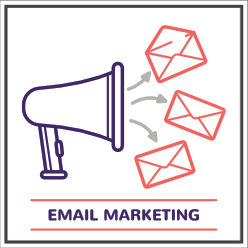It's still spam
- laura
- April 26, 2016
- Best practices
Companies are always trying to find new ways to use and abuse email. My mailbox has been rife with mail from companies trying to sell me stuff for my business. It’s been interesting to watch the new ways they’re trying to get attention, while not honoring the most important rule of email marketing.
Marketing Automation
The advent of “marketing automation” has added a new dimension to how companies can spam leads. They don’t need to do anything and can bug hundreds or thousands of people over time with one simple step. Maybe their prospect will get so annoyed they respond! Just to get you to leave them alone!
I’ve been watching with some fascination as a UK company is trying to sell me… something. They’ve been vague in all the emails I’ve received so far.
Email 1: Let me show you all this great stuff we can do for you.
Email 2: You didn’t answer me the first time, but, really, we have great stuff for you.
Email 3: I’m having trouble contacting someone, can you tell me who the right person at your company is to talk to about all my great stuff?
If you ignore email 3, they simply add you to random mailing lists at their company. I’ve gotten 2 different ads for webinars from them in the last 3 hours.
All the emails violate CAN SPAM. The first 3 don’t have any unsub links. The last 2 don’t have a postal address.
These emails aren’t relevant. They’re not targeted. They’re not even personalized. At least the folks that harvest our contact address and spam it pretend they’ve visited our website. No, this is just blatant spam from some company. Spam I don’t seem to be able to opt-out of.
The LinkedIn Harvest
As with most of my website subscriptions, LinkedIn has a tagged address of mine. That means I know exactly who is harvesting it and adding it to their lists. It happens a lot less than you would think, but it does happen.
The most recent example was an Indian ESP that added my address to their webinar announcement list. Multiple emails advertising different webinars. Again, these emails had no unsubscribe and no postal address. Considering the address was blatantly harvested, that’s triple damages if I were to take them to court.
Ironically, one of the webinars they were advertising was about deliverability. They were going to discuss the new changes at Gmail and how to get to the inbox anyway. Even funnier is that their delivery guy was in my mailbox a few weeks ago asking me about Gmail, what I knew and what I would recommend to them and their clients.
First recommendation: Stop harvesting addresses and spamming people.
B2B Spam is Still Spam
There is this view by some marketers that permission doesn’t matter when sending B2B mail. That purchased lists, harvested lists, and mail violating CAN SPAM are all OK if your recipient is at work. In fact, one of the questions I recently fielded was about getting through corporate filters.
In reality, delivery to businesses is harder than delivery to consumers, even for opt-in lists. Businesses operate email systems to further their own business goals. If incoming mail is distracting or annoying to their employees, they can and will block the source. Annoy the wrong person and you really will discover how hard it is to get into businesses.
Now, it’s easier now than it used to be. Most businesses are outsourcing their filtering. Previously outsourcing was to companies who handled the filtering or managed on premise appliances. But now we’re seeing a lot of companies outsource to webmail providers like Office365 and Google Apps. This means some of the engagement rules are now being applied to business delivery.
This may make business delivery easier in some ways. But it is going to make permission a much bigger deal in the B2B space.
Update: Al wrote about B2B spam today, too. His blog post is worth a read, too.